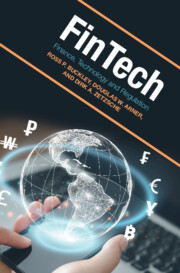Book contents
- FinTech
- FinTech
- Copyright page
- Contents
- Figures
- Acknowledgements
- Abbreviations and Technical Terms
- 1 Introduction
- Part I Digital Transformation of Finance and Regulation
- Part II Addressing the Challenges of Innovation in Finance
- Part III Building Better Financial Systems
- 12 Building the Infrastructure for Digital Financial Transformation
- 13 Digital Identity
- 14 Electronic Payments, Stablecoins, and Central Bank Digital Currencies
- 15 Digital Financial Transformation
- Part IV From FinTech to TechFin to BigTech to FinTech 4.0
- Part V Conclusion
- Index
14 - Electronic Payments, Stablecoins, and Central Bank Digital Currencies
from Part III - Building Better Financial Systems
Published online by Cambridge University Press: 09 November 2023
- FinTech
- FinTech
- Copyright page
- Contents
- Figures
- Acknowledgements
- Abbreviations and Technical Terms
- 1 Introduction
- Part I Digital Transformation of Finance and Regulation
- Part II Addressing the Challenges of Innovation in Finance
- Part III Building Better Financial Systems
- 12 Building the Infrastructure for Digital Financial Transformation
- 13 Digital Identity
- 14 Electronic Payments, Stablecoins, and Central Bank Digital Currencies
- 15 Digital Financial Transformation
- Part IV From FinTech to TechFin to BigTech to FinTech 4.0
- Part V Conclusion
- Index
Summary
Cryptocurrencies are reshaping money and payment systems in unprecedented ways. Catalysts include the launch of Bitcoin in 2009, the evolution of decentralised and centralised technologies, the announcement of Libra in 2019, the ongoing live trials of China’s Digital Yuan, and the COVID-19 pandemic and the related move to presenceless payments.This chapter considers the policy issues and choices associated with cryptocurrencies, stablecoins, and central bank digital currencies (‘CBDCs’) and emphasises that there is no single model for CBDC design. The catalysts reshaping monetary and payment systems challenge regulators. While Bitcoin and its thousands of progenies could be ignored safely by regulators, Facebook’s proposal for Libra, a global stablecoin (‘GSC’), brought an immediate and potent response from regulators globally. This proposal by the private sector to move into the traditional preserve of sovereigns– the creation of currency– was always likely both to trigger such a regulatory response and the development of CBDCs by central banks. China has moved first with its e-CNY– an initiative that may, in time, provoke a chain of CBDC issuance around the globe.
- Type
- Chapter
- Information
- FinTechFinance, Technology and Regulation, pp. 215 - 233Publisher: Cambridge University PressPrint publication year: 2023



